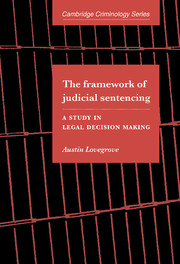Book contents
- Frontmatter
- Contents
- List of figures
- List of tables
- Acknowledgments
- 1 Judicial decision making and sentencing policy: continuation of a study
- 2 A sentencing decision model: single and multiple similar counts
- 3 A sentencing decision model: multiple disparate counts
- 4 Testing the decision model for multiple disparate counts
- 5 The techniques of data collection
- 6 Judges' thoughts on sentencing the multiple offender
- 7 An alternative sentencing decision model for the multiple offender
- 8 Validity and development of the alternative decision model: the data collection
- 9 Towards a requisite decision model for sentencing the multiple offender
- 10 The armature of judicial sentencing
- Appendix 1 Case 37 from Sentencing Research Exercise – Part 3B
- References
- Index
3 - A sentencing decision model: multiple disparate counts
Published online by Cambridge University Press: 22 August 2009
- Frontmatter
- Contents
- List of figures
- List of tables
- Acknowledgments
- 1 Judicial decision making and sentencing policy: continuation of a study
- 2 A sentencing decision model: single and multiple similar counts
- 3 A sentencing decision model: multiple disparate counts
- 4 Testing the decision model for multiple disparate counts
- 5 The techniques of data collection
- 6 Judges' thoughts on sentencing the multiple offender
- 7 An alternative sentencing decision model for the multiple offender
- 8 Validity and development of the alternative decision model: the data collection
- 9 Towards a requisite decision model for sentencing the multiple offender
- 10 The armature of judicial sentencing
- Appendix 1 Case 37 from Sentencing Research Exercise – Part 3B
- References
- Index
Summary
The purpose of this chapter is to develop a model describing how judges determine quantum of sentence for a case comprising multiple counts belonging to different offence categories (e.g., armed robbery and burglary) and properly regarded as separate transactions. Again, it is to be what has been described in this study as an ideal model of decision making. The present analysis begins by exploring how the previous decision model, covering offences of the same kind, provides a foundation for the decision model relating to offences of a different kind; it continues with a statement of the proposed model, described in terms of sixteen principles.
One critical element in the just-described solution to the problem of determining the overall seriousness of a series of offences of the same kind is the viewing of seriousness as an aggregation of the seriousness associated with dimensions describing aspects of the seriousness of a case viewed as a whole: for burglary these four dimensions are the characteristic level of organization of the offences, the level of violence in the most violent of the offences, the number of offences, and the total amount stolen. This decision structure is compatible with the totality principle, requiring, as it does, the sentencer to fix a sentence proportional to the offender's course of criminal conduct viewed as a whole. This global notion of case seriousness is similarly appropriate for cases comprising multiple counts from different offence categories, since the totality principle applies in that sort of case as well.
- Type
- Chapter
- Information
- The Framework of Judicial SentencingA Study in Legal Decision Making, pp. 52 - 61Publisher: Cambridge University PressPrint publication year: 1997



